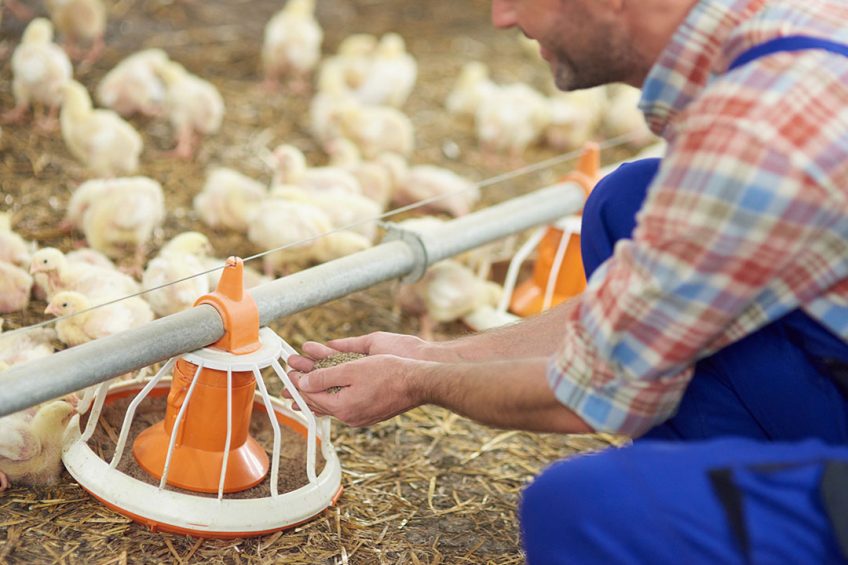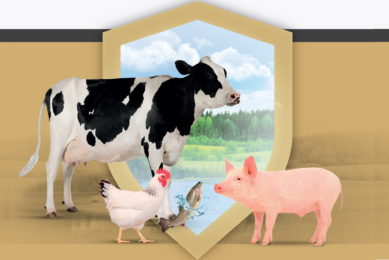Multi-mycotoxins, an underestimated risk

One single fungus can produce different mycotoxins which can lead to several cases of co-contaminations. Various mycotoxins produced by different fungus can also be present at the same time in raw materials and feeds. Multi-mycotoxin contaminations can induce additive, synergistic and antagonistic effects.
Mycotoxins are natural contaminants of animal feeds and feed ingredients. They are present in cereal grains as well as forages and produced by fungi under certain conditions of moisture and temperature. The five most known groups of mycotoxins (aflatoxins, fumonisins, trichotecenes, ochratoxins and zearalenones) are produced by the three principal genera of Fusarium, Aspergillus and Penicillium. Feeds are frequently contaminated simultaneously by several moulds which are able to produce several mycotoxins. Up to 70% of the samples analysed for mycotoxins contain more than one mycotoxin.
Antagonistic effects
Few studies demonstrate that multi-mycotoxin contamination can induce additive, synergistic but also antagonistic effects. Those combined effects remain little understood and the negative impacts in animals remains poorly taken into account today. The meta-analysis of Grenier et al. (2011) defined the different interactions existing between mycotoxins. The synergistic effects, can be divided into three sub-categories:
- The first one corresponds to experiments where the effect of the mycotoxins’ combination was greater than expected from the sum of the individual effects of the two toxins.
- The second type defines the experiments where two mycotoxins induce opposite effects, and the combined treatment induces an effect greater than the individual ones.
- Finally the third type, when two mycotoxins induce similar effects and the combination induces opposite effects than the individual ones.
Antagonistics effects can be split into two sub-categories:
- Type 1 corresponds to the situation where two mycotoxins induce similar effects and the combination induces a lower effect.
- Type 2 reflects the state where two mycotoxins which do not induce the same effects and with a combination inducing an intermediate effect between the two individual ones.
Additive effects include experiments where the impact could be calculated as the sum of the individual effects of the two toxins. The combination of mycotoxins are multiple and the type of impacts on the animals even more so, and these are not always easily predictable.
Examples of combined effects
Toxic synergism of aflatoxin and ochratoxin in comparison to the individual toxins effects in poultry was studied by R. Ramo (2007). A significant (p-value 0.05) decrease in body weight of birds receiving aflatoxins and ochratoxins simultaneously was observed. The individual mycotoxin supplementation decreased the body weight by 12% each at 3 weeks of age, while the combination decreased body weight by 40%. Aflatoxin is well known as hepatotoxin and ochratoxin as nephrotoxin, which is a useful distinction for field contamination diagnosis. But in this study the most sensitive organ of the synergistic effect of these two mycotoxins was the kidney. Pathological changes were more pronounced in this organ demonstrating a higher toxicity.
Synergistic effects related to nephrotoxicity
Furthermore, interactions between two nephrotoxic mycotoxins (ochratoxin and citrinin) was studied by Speijers et al. (2004). Depending on the studies, synergistic, and/or additive or antagonistic effects have been highlighted. However, many studies have shown synergistic effects related to the nephrotoxicity. A. Molinié (2004) explains that the citrinin was able to modify the distribution and elimination of the ochratoxin, leading to a more toxic impact of ochratoxin for the kidney. Moreover, some studies consolidated by Grenier et al., 2011, have investigated the combined effect of aflatoxin and T2-toxin on body weight gain. All of them demonstrate at least an additive, or a synergistic interaction between both toxins. Similar interaction was also observed on the relative weight of some organs (liver, kidney).
Developing and testing T5X product
Wisium’s research and development team therefore developed and tested the T5X product to address this issue. The zootechnical performances of broilers facing a contamination of aflatoxins, ochratoxins, T2 toxin and citrinin at the same time, was studied with and without T5X included in the feed. The research was conducted on a total of 78 Cobb broilers in R&D conditions in Mexico. A full HPLC analysis was done in order to evaluate the contamination of sorghum contained in the feed of the contaminated and T5X groups. The contamination levels are detailed in Table 1.
Zootechnical performances
The 78 broilers were divided in three groups (26 broilers per group); (A) Non-contaminated group, (B) Contaminated group, (C) B plus T5X supplemented at 1kg/T. The experimental period started from day 1 to 42 days of age. All the animals received a diet based on sorghum (contaminated or not) and soya ad libitum. A starter feed was distributed from 1 to 21 days, and a grower feed from 22 to 42 days. The zootechnical performances (feed intake, weight gain, feed conversion ratio) and mortality rate were measured.
Figure 1 – Zootechnical performances of the groups.
Negative impacts of multi-mycotoxins
The results demonstrate the significant negative impact of a multi-mycotoxin contamination on the animals. A significant decrease in weight gain of 7.2% for the contaminated group (B) in comparison to the non-contaminated group (A) was observed, see Figure 1. The FCR was also affected, 1.66 for the contaminated group (B) versus 1.56 for the non-contaminated one (A). The T5X group showed a significant higher weight gain + 9.7% in comparison to the contaminated group (B), and an increase of 0.9% of feed intake. Those results lead to a better FCR (-7.8%) for the T5X group in comparison with group (B). The mortality rate increased for the contaminated group in comparison to the non-contaminated group, 15.4% versus 0%. T5X group has a lower mortality rate than the contaminated group, 7.7%.
Mycotoxins validated
The multi-mycotoxin contamination administrated to broilers affected their zootechnical performances (weight gain: -7.8%; feed intake: -1.2%; FCR: +6.0%), validating the mycotoxins challenge in this trial. The addition of the product into the feed allows to counteract harmful effects of a multi-contamination in broiler feed (Aflatoxins B1, Ochratoxin, T2 toxin and Citrinin). Furthermore, in weight gain and FCR, the animals achieved better results than the non-contaminated control. Not only T5X, but also the mycotoxins’ global approach of Wisium, including quality control plan, analysis, and several years of R&D allowed to precisely measure the mycotoxin risk and to implement the right strategy.
Author: Morgane Piriou, T5X Product Manager, Wisium
References available on request







